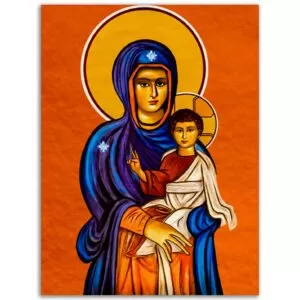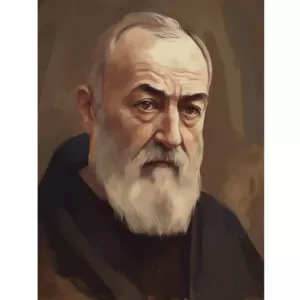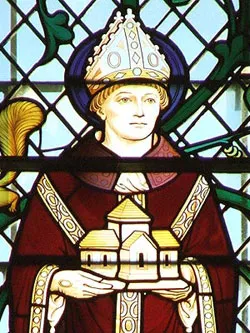SAINT LOUIS MARIE de MONTFORT

SAINT LOUIS MARIE de MONTFORT
Eary Years|
Works|
Apostle|
Teachings
Early Years
Louis was twelve when he entered St. Thomas’s, a Jesuit college in Rennes. He eagerly
devoted himself to the care of the poor and the infirm. It was here that he received his vocation to the priesthood. His abandonment of worldly attachments by giving up his family name to be known simply as Louis Marie of Montfort is an example of his devotion.
His Works
Father de Montfort was ordained in 1700. There were over 100,000 ecclesiastics in the
country, 130 bishops, more than l,000 abbeys, and “a veritable galaxy” of lesser
monasteries. All the great Orders, as well as forty-two new religious congregations founded in the previous century flourished.
Saint Montfort, the obedient slave and champion of the Sovereign Queen of Heaven, found little favor in his native country. Jansenism had become so widespread that this holy priest for the sixteen years from his ordination to his death was to enjoy a life whose most conspicuous routine was enduring ridicule, humiliation, slander, threats, contradiction, interdiction, and ostracism. Saint Louis Marie loved nothing more than to suffer calumnies and persecution for his Master Who said: “If anyone will come after Me, let him deny himself, and take up his cross, and follow Me.” He prayed constantly for such crosses, in fact, and accordingly was blessed with an abundance of them. For he was repetitiously driven by his enemies from one diocese to another—from Nantes to Poitiers, to Angers, to Orleans, to Tours, to Paris, to Rennes, to Rouen, and back, again and again—in triumphant persecution. Once he had been seen dragging himself on his hands and knees, pleading, “O Mother of God, help me!” His assailant was Satan, as was confirmed in a letter written by Saint Louis Marie From Paris, saying, “Men and devils make war on me in this great city….”
It was a year after ordination before Louis finally obtained permission to preach. Conducting his first missions at Poitiers where he also performed his first miracle by curing a blind man he produced countless moral conversions. Capturing completely the affections of the poor that they begged the bishop to give “kind Father de Montfort” a more definite assignment amongst them. He was made chaplain of a local hospital—a poorhouse governed in chaos, abuse, and neglect.
In 1704 he arrived at another hospital in Paris where he found that spiritual formation of most of the five thousand impoverished inmates had never progressed beyond the baptismal. Entering as an assistant chaplain, Father de Montfort treated both the physical and spiritual afflictions of his poor patients portraying a compelling day-to-day sermon. He would cleanse their wounds at the same time that he washed the defilements of their souls with absolution. He said: “It is not the healthy who need a physician but they who are sick. For I have not come to call the just, but sinners.” Such eloquence of mercy excited Jansenist retaliation. At evening dinner the saint found a note of dismissal on his plate.
Saint Montfort returned to the hospital at Poitiers and remained there a year before he again forced his departure. He was permitted to preach in outlying towns—filthy slums where the sight of a priest aroused bitter hatred. In time he worked so complete a conversion of these villages that evening Rosary devotions and processions became a way of life for all. Chapels were restored, saloons were converted into Rosary shrines, bonfires were built for burning impure books and pictures, confessions were heard in unending numbers, miracles were performed, people’s courts were convened under “Magistrate” Montfort for resolving disputes; and a hospital for incurables was begun. Somebody in a position of power resented these spectacular achievements and he was summarily expelled from the diocese.
Apostle of France
Several years passed and Saint Louis still had no more idea of what his specific service to God was to be than he had on the day he was ordained. At least three times he had tried to devote his life to the poor and had met obstacles. He had always wanted to work in foreign missions while at the same time he confessed an attraction to the contemplative life. Since his only reply from hierarchical superiors was hindrance rather than help he decided to seek the counsel of the Pope. Walking a thousand miles to Rome, resting only at the Holy House of Loreto, he was granted an audience with His Holiness on June 6, 1706. Clement XI intuitively sensed beyond the humble appearance of the beggar priest before him that here was a man of extraordinary sanctity. The Pope assured Louis Marie that there was more than enough work for him in France and appointed him as Apostolic Missioner.
Returning home Montfort joined the famous missionary company of Father Leuduger and
spent eight months with him evangelizing the northeast provinces of France. It was during this time that he fulfilled Saint Vincent’s prophecy. Rebuilding the ruined church at La Cheze while somehow continuing uninterruptedly to conduct a major mission. His miracles throughout this period were numerous and included several instances of his multiplying fragments of food during a time of famine.
A young girl had been traveling a great distance to attend one of his missions. She arrived one day only to realize that she had forgotten to bring food for her return trip. As she sat on the church steps, exhausted, hungry, and too shy to ask for help appeared “a beautiful lady offered her a piece of bread, saying gently, ‘Take this, my child, and eat it.’ A moment later she disappeared.”
A group of about a dozen thugs brutally attacked Montfort, intending to beat him to death. This was the second attempt on his life and like the first it was unsuccessful. Under estimating the humble saint’s might the assailants soon found themselves in fear for their own lives and quickly retreated.
His work in Nantes continued bringing with it many conversions and miracles. For example, barren soil where his foot had trod, soon issued healthy harvests. There were several reported apparitions of Our Lady to peasants following his missions.
The saint long since had adopted the practice of erecting impressively large Calvary scenes at the close of his missions. The grandest that he had ever undertaken was the Calvary at Pontchateau thirty miles from Nantes. Though work on it had already begun, Louis remained doubtful about the site chosen for it and interrupted construction long enough to assemble his crew in the chapel to pray for Our Lady’s guidance. When work resumed two doves were observed gathering dirt in their bills, flying away, and returning repeatedly for more. Discovering that the destination of the winged excavators was the highest point in Pontchateau, Montfort immediately recognized this sign from the Blessed Mother and relocated his operation. Thirty-six years earlier crosses were seen to descend from heaven amidst a great noise and singing and to suspend over this very spot—on the same day that Saint Louis Marie was born. The undertaking continued through a hard winter during which time many miracles of the usual variety occured. “A omen of unearthly beauty” was seen appearing to Montfort on several occasions. Surmounted with three huge crosses—one fifty feet tall—and surrounded by an elaborate Rosary and gardens representing Eden and Gethsemane. The Calvary of Pontchateau was completed in 1710.
One of his enemies seeded the suspicion that the enormous shrine which was to be solemnly blessed on the Feast of the Exaltation of the Holy Cross could be used as a military stronghold by
foreign powers warring on France. On the eve of the Feast, Father de Montfort received orders from the bishop prohibiting the blessing. Shortly afterwards the Calvary masterpiece was completely leveled. Saint Louis had prophesied that his beautiful Passion site would be destroyed and rebuilt twice before it would survive for the ages.
Clouds of ecclesiastical censure finally parted in 1711 for the Breton priest. He was invited to work in the diocese of La Rochelle and from then on was able to preach an almost unbroken succession of missions with the wholehearted support of Bishop Champflour. While assured of the bishop’s staunch backing Saint Louis had no relief from the hateful torments to which he had become so well accustomed. Much to the contrary, both Jansenism and Calvinism proved mighty forces to be contended with in the La Rochelle district. To illustrate, several attempts on his life by now already had been made, and fortunately—sometimes miraculously—he had escaped them all. But when he converted two of this city’s most prominent and vocal Protestants—one of whom entered a convent of Poor Clares—Calvinist rage could not be quieted. Threats were made against both the converts and Louis Marie. Frequently the great priest was greeted with a hail of stones, and more frequently with cries of “Kill Montfort!” One evening a powerful dose of poison was administered to his broth. Though he swallowed but a mouthful before noticing the deadly presence, the wicked deed was accomplished. Saint Louis did not die immediately from the poison, but the solution was so concentrated that even the small amount of a spoonful ravaged and gravely undermined his once robust health and the slow agonizing process of death was begun.
Though most of the time in the few years left for him was spent in the diocese of La Rochelle Saint Louis Marie continued to make excursions to whatever places in France poor souls could be found. On his third and final visit to Rennes his evangelizing was met only with stubborn obstinacy. He wrote in a farewell poem that a curse was upon the city and warned of its destruction. Five years later most of Rennes was razed by a fire which raged for ten days.
He was asked to preach a mission on the Island of Yeu. England and France at the time were at war, and the waters he would have to cross were thick with English pirates. A miracle saved him and his company only a moment before two English warships could overtake them. Today a large boulder at the base of a steep hill gives testimony to the great saint’s arrival on the Island of Yeu. It had once been at the top of that hill, occupying the spot where Saint Louis decided to erect a Calvary cross. Several men had tried unsuccessfully to budge what the Breton priest
dislodged with a touch.
On Palm Sunday he began a mission at St. Laurent-sur-Sevre. It was to be his last. Leaving the pulpit one day he was at the point of collapsing and had to take to his bed. His confessor ordered that the straw and the rock-pillow on which the holy man normally slept be replaced with a mattress. Louis reluctantly but obediently submitted and was given the Last Rites. Yet he insisted on receiving the many followers who wanted one last blessing from their beloved saint.
For several days he lay there dying with a statue of the Blessed Virgin in one arm and the indulgenced crucifix given him by Pope Clement XI in the other. He gave his last will and testament, asking that his heart be buried “under the steps of the altar of the Blessed Virgin.” On the following day, April 28, 1716, Satan made a final desperate bid, to which Saint Louis retorted loudly, “You attack me in vain; I stand between Jesus and Mary. I have finished my course. I shall sin no more.” With that the soul of Saint Louis Marie de Montfort was taken into Heaven. And his entire body was laid to rest beneath the altar of the Queen he loved so much.
His Teachings
As a preacher he taught a simple people with simple lessons. Since the poor of France could not read, he gave them a treasure of humble yet beautiful poems and hymns by which they learned and long sustained their childlike faith. But as the Apostle of all later ages he presents a striking contrast in his teaching facilities.
Saint Louis Marie wrote five significant compositions, all of which are still in wide circulation even today. They are Love Of The Eternal Wisdom, Friends Of The Cross, True Devotion To The Blessed Virgin, The Secret Of Mary, and The Secret Of The Rosary. Georges Rigault aptly summarizes these works, observing, “Three words cover his teaching: Wisdom, the Cross, the Virgin—words which belong to each other: No Wisdom outside the Cross and without the aid of the Virgin.”
Wisdom here does not mean sagacity in the natural sense. Rather, it means “Jesus
Christ, the Eternal Word of God, the second Person of the Blessed Trinity, Who took flesh in the womb of the Virgin Mary.” Saint Louis Marie writes, “To know Jesus Christ, the Eternal Wisdom, is to know enough. To know everything and not know Him is to know nothing. A thousand times happier is the man into whose soul Wisdom has come to dwell. To acquire Wisdom we must seek Him ardently. We must be willing to abandon all, to suffer all, and to undertake all things in order to possess Him. There are but few who find Him because there are but few who seek Him in a manner worthy of Him.”
He teaches the necessity of the Cross: “Born in the sorrowful Heart of the Saviour, a friend of the Cross comes into the world through His right side, stained with His Blood; he never forgets his birth and crosses, death to the world, the flesh, and sin are all he lives for, that even in this world he may be hid with Christ in God. He triumphs over the devil, the world, and the flesh and their three-fold concupiscence. He overthrows the pride of Satan by his love for humiliation, he triumphs over the world’s greed by his love for poverty, and he restrains the sensuality
of the flesh by his love for suffering.”
But the surest, the easiest, the happiest, the most perfect way to Jesus Christ is through Mary. And this brings us to the great genius of Saint Louis Marie in explaining Our Lady’s role in the redemption of mankind. In his treatise on True Devotion To The Blessed Virgin, he wrote, “It is through the most holy Virgin Mary that Jesus came into the world, and it is also through her that he has to reign in the world. It was through Mary that the salvation of the world was begun, and it is through Mary that it must be consummated. Devotion to Our Blessed Lady is necessary for salvation. He who has not Mary for his Mother has not God for his Father.
“It is necessary for the greater knowledge and glory of the Most Holy Trinity, that Mary should be more than ever known. Mary must shine forth more than ever in mercy, in might, and in grace in these later times*: in mercy to bring back and lovingly receive the poor strayed sinners who shall be converted and shall return to the Catholic Church; in might, against the enemies of God, idolaters, schismatics, Mahometans, Jews, and souls hardened in impiety, who shall rise in terrible revolt against God. She must shine forth in grace in order to animate and sustain the valiant soldiers and faithful servants of Jesus Christ who shall battle for His interests.
It is clear that Saint Louis Marie was speaking here in prophecy, as he also foretold that Satan would cause his treatise to be lost. True Devotion was not discovered until one hundred and twenty-six years after his death.
How does one become a slave of the Blessed Virgin? The easiest way is by first carefully studying True Devotion, for which Pope Saint Pius X granted an Apostolic Benediction. Then by confidently making, and faithfully living by, the following Act of Consecration to the Mother of God, composed by Saint Louis Marie de Montfort: In the presence of all the Heavenly Court I choose thee this day for my Mother and Mistress. I deliver and consecrate to thee, as thy slave, my body and soul, my goods, both interior and exterior, and even the value of all my good actions, past, present and future; leaving to thee the entire and full right of disposing of me, and all that belongs to me, without exception, according to thy good pleasure, to the greatest glory of God, in
time and in eternity.
rosary.team
















